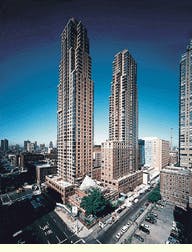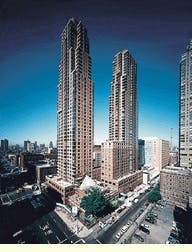Posh Manhattan units get wired for desktop video, Internet, enhanced phones, and cable TV.
Grace F. Murphy
If James Bond lived in Manhattan, he would probably reside in The Grand Millenium on the Upper West Side and forgo some of his high-tech toys. For beneath the building`s posh exterior lies a telecommunications network that offers services usually limited to commercial buildings.
Bond would likely feel equally at home in either of DualStar Technologies Corp.`s other New York City sites--One Columbus Place on Ninth Avenue and 59th Street, or Citylights at Queens Landing in Queens. Thanks to a combination of fiber-optic and copper-cable networks installed during building construction, each residential unit is wired for multimedia applications such as desktop videoconferencing and video-on-demand, high-speed Internet access, enhanced telephone service, and cable TV.
The Grand Millenium is a 300-unit condominium residence and hotel at 1965 Broadway. One Columbus Place consists of two 51-story towers, and the nearly completed Citylights is a 530-unit high-rise.
The people who live in these buildings are not fictional agents with a license to kill, but real-life technocrats who want both luxury and a wired home office fitted with a T1 (1.544-megabit-per-second) line so they can download multimedia files 50 times faster than the standard 28.8-kilobit-per-second modems. Others want to telecommute from home, trade stocks after market hours, or cybersurf and watch television at the same time.
DualStar Technologies Corp. (Long Island City, NY) made that easy for residents. As each property was built, DualStar Communications Inc., a wholly owned subsidiary of DualStar Technologies, wired the building and installed what it terms "building area networks" (bans). 3Com Corp. (Santa Clara, CA) provided the network infrastructure with its SuperStack line, and Fujitsu Business Communications Systems (Anaheim, CA) supplied its Multimedia Platform for call-handling features. The buildings have a different number of stories and features but are basically cabled the same way.
Each ban network consists of six 100-Mbit/sec segments supported by a singlemode fiber-optic backbone that brings Fast Ethernet connectivity to each unit. Residents put an Ethernet card into their computer, plug into a port, and find themselves in the network.
The fiber-optic backbone connects to a 3Com SuperStack II Switch 3000 in a communications room in the basement of the buildings, according to Vincent D`Onofrio, president of DualStar Communications. A pair of six-strand fiber-optic cables run up the building risers, where they terminate in 3Com`s SuperStack II Switch 1000s. Approximately 400 feet of fiber-optic cable is used at The Grand Millenium, 650 feet of fiber-optic cable per tower at One Columbus Place, and just over 500 feet of fiber-optic cable at Citylights at Queens Landing, says D`Onofrio.
The switches accept the 100-Mbit/sec fiber feed and run over 10-Mbit/sec feeds to SuperStack II Port Switch Hubs. A horizontal run of Category 5 copper cable connects the hubs and apartments. There is one wiring closet for every six floors at The Grand Millenium, one closet for every three floors at One Columbus Place, and one closet per tower at Citylights at Queens Landing.
Some residents may choose private local area networks, either for extra security or priority Internet access, according to Robert Birnbach, DualStar Technologies` chief financial officer. "With the premium service, no segment shares with the other users; they`re connected directly to the Fast Ethernet [100-Mbit/sec] port," he says. Otherwise, residents may share a port with four other users.
Back in the basement communications room, a wide area network based on 3Com`s SuperStack II netbuilder routers provides the building network`s Internet connections. The routers support the T1 connections to a central netbuilder II router in Manhattan. The central router is linked to Cable and Wireless, DualStar Communications` Internet service provider.
Cyberbuilding residents aren`t choosing their homes on the basis of cheap rent (condominiums in The Grand Millenium range from $319,000 to $3.4 million, while one-bedroom apartments at One Columbus Place start at $2100 per month). They want fast Internet access and other computer conveniences and are willing to pay for them. That made the decision to go with a fiber-optic backbone in the buildings a natural one, says D`Onofrio. Using fiber made sense, considering the distance that data has to travel, the medium`s ability to scale various speeds, and other technologies that users may demand in the future, he says.
"Although we`re using 100Base-T [Fast Ethernet], in the future we can run either atm [Asynchronous Transfer Mode] or Gigabit Ethernet to the backbone, and we don`t have to replace [the backbone]," D`Onofrio adds.
Planning ahead
Birnbach says that even though the "smart buildings" are providing a desired, convenient service to residents, DualStar had to plan ahead. "We attempted to futureproof the building. The fiber can handle the speed and can handle what`s coming up," he says.
D`Onofrio says it wasn`t practical to connect the hubs with the individual PCs with fiber-optic cable because the Category 5 cable is capable of handling the upcoming technologies.
In addition to having unlimited access to the Internet, each apartment has its own e-mail account. D`Onofrio says the company is getting some e-mails asking about future services, such as Internet telephony. The day-to-day computer problems and questions are handled by the building CyberCierge, which is an information technology support service.
While DualStar has been approached to bring its construction and telecommunications skills elsewhere, officials say there are no immediate plans to build CyberBuildings in locations other than in New York City. "We`re focused on getting our house in order," Birnbach says.
The fiber backbones at One Columbus Place`s 51-story towers will allow upgrades from Fast Ethernet to Asynchronous Transfer Mode or Gigabit Ethernet.
Grace F. Murphy was formerly assistant editor at Lightwave magazine, another PennWell publication. This article first appeared in the January 1998 issue of Lightwave.

